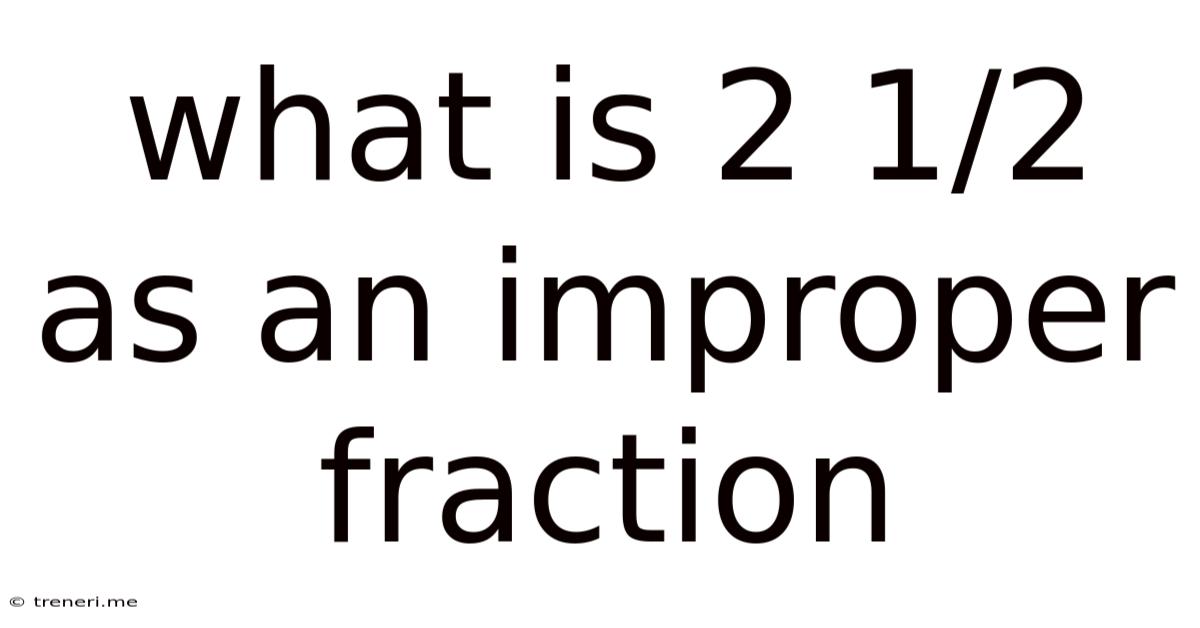What Is 2 1/2 As An Improper Fraction
Treneri
May 09, 2025 · 4 min read

Table of Contents
What is 2 1/2 as an Improper Fraction? A Comprehensive Guide
Understanding fractions is a fundamental skill in mathematics, crucial for various applications in everyday life and advanced studies. This comprehensive guide will delve deep into converting mixed numbers, like 2 1/2, into improper fractions. We'll explore the concept, the step-by-step process, and various examples to solidify your understanding. We'll also touch upon the practical applications of this conversion and how it relates to other mathematical concepts.
Understanding Mixed Numbers and Improper Fractions
Before diving into the conversion, let's clarify the definitions:
-
Mixed Number: A mixed number combines a whole number and a proper fraction. A proper fraction is a fraction where the numerator (the top number) is smaller than the denominator (the bottom number). For example, 2 1/2 is a mixed number; 2 is the whole number, and 1/2 is the proper fraction.
-
Improper Fraction: An improper fraction is a fraction where the numerator is greater than or equal to the denominator. For example, 5/2, 7/3, and 10/10 are improper fractions.
Converting a mixed number to an improper fraction involves representing the whole number as a fraction with the same denominator as the fractional part and then combining the numerators. This allows us to express the entire quantity as a single fraction.
Step-by-Step Conversion: 2 1/2 to an Improper Fraction
Let's break down the conversion of 2 1/2 into an improper fraction step-by-step:
Step 1: Multiply the whole number by the denominator.
In our example, the whole number is 2, and the denominator of the fraction is 2. Therefore, we multiply 2 * 2 = 4.
Step 2: Add the numerator to the result from Step 1.
The numerator of our fraction is 1. Adding this to the result from Step 1, we get 4 + 1 = 5.
Step 3: Keep the same denominator.
The denominator remains unchanged. It stays as 2.
Step 4: Write the improper fraction.
Combining the results from Step 2 and Step 3, we get the improper fraction 5/2.
Therefore, 2 1/2 is equivalent to 5/2.
Visualizing the Conversion
Imagine you have two and a half pizzas. Each pizza is divided into two equal slices. You have two whole pizzas (four slices) and half a pizza (one slice). In total, you have five slices, each representing 1/2 of a pizza. This visually represents 5/2.
More Examples: Mastering the Conversion
Let's practice with a few more examples to solidify your understanding:
Example 1: Converting 3 2/5 to an Improper Fraction
- Multiply: 3 * 5 = 15
- Add: 15 + 2 = 17
- Keep the denominator: 5
- Improper fraction: 17/5
Therefore, 3 2/5 = 17/5
Example 2: Converting 1 3/4 to an Improper Fraction
- Multiply: 1 * 4 = 4
- Add: 4 + 3 = 7
- Keep the denominator: 4
- Improper fraction: 7/4
Therefore, 1 3/4 = 7/4
Example 3: Converting 5 1/3 to an Improper Fraction
- Multiply: 5 * 3 = 15
- Add: 15 + 1 = 16
- Keep the denominator: 3
- Improper fraction: 16/3
Therefore, 5 1/3 = 16/3
The Reverse Conversion: Improper Fraction to Mixed Number
It's equally important to understand the reverse process: converting an improper fraction back to a mixed number. This involves dividing the numerator by the denominator. The quotient becomes the whole number, the remainder becomes the numerator, and the denominator remains the same.
Example: Converting 7/4 to a Mixed Number
- Divide: 7 ÷ 4 = 1 with a remainder of 3
- Whole number: 1
- Numerator: 3
- Denominator: 4
- Mixed number: 1 3/4
Therefore, 7/4 = 1 3/4
Practical Applications of Improper Fractions
Improper fractions are valuable in various real-world scenarios and mathematical applications:
-
Cooking and Baking: Recipes often require fractional measurements. Converting mixed numbers to improper fractions simplifies calculations when dealing with multiple recipes or scaling recipes up or down.
-
Construction and Engineering: Precise measurements are critical in construction and engineering. Improper fractions provide a more accurate representation of measurements than mixed numbers in certain contexts.
-
Advanced Mathematics: Improper fractions are fundamental in algebra, calculus, and other higher-level mathematics. They simplify calculations and facilitate problem-solving in more complex equations and expressions.
Understanding the Relationship to Decimals
Both improper fractions and decimals can represent the same value. For example, 5/2 is equivalent to 2.5. Converting between improper fractions and decimals involves either dividing the numerator by the denominator (fraction to decimal) or expressing the decimal as a fraction (decimal to fraction), which might then need simplification to an improper fraction.
Conclusion: Mastering Fraction Conversions
Mastering the conversion between mixed numbers and improper fractions is a crucial skill in mathematics. This comprehensive guide provided a step-by-step process, illustrated examples, and practical applications to enhance your understanding. Remember, consistent practice is key to mastering this fundamental concept, paving the way for success in more advanced mathematical concepts and real-world applications. By understanding these conversions, you are building a solid foundation for future mathematical endeavors. Practice regularly, and you'll find these conversions become second nature!
Latest Posts
Latest Posts
-
1 424 Rounded To The Nearest Hundredth
May 10, 2025
-
How Many Days Til June 19
May 10, 2025
-
How Much Does A Pound Of Quarters Weigh
May 10, 2025
-
3 To The Second Power Equals
May 10, 2025
-
How Many Miles Is 86 Km
May 10, 2025
Related Post
Thank you for visiting our website which covers about What Is 2 1/2 As An Improper Fraction . We hope the information provided has been useful to you. Feel free to contact us if you have any questions or need further assistance. See you next time and don't miss to bookmark.